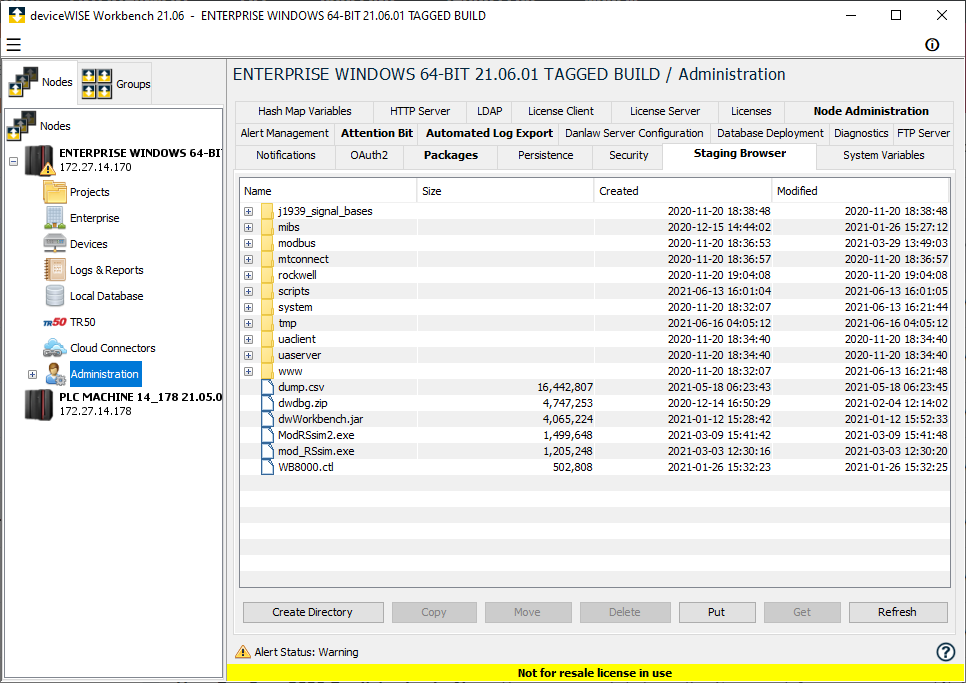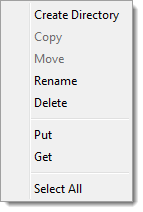The Staging Browser tab is used to access
the files and directories in the node's Staging Browser
area. A node's Staging Browser area is permanent storage
implemented using the node's storage resource such as a
disk drive, a compact flash (CF) card, a secure digital
(SD) card, and so on.
The Staging Browser tab displays the directories and files in a table with columns for the Name of the directory or file, the Size of the file, the Created date and time and the Modified date and time.
There are some system defined directories and files in the Staging Browser area. Applications can manage directories and files in the Staging Browser area as part of their logic by using the Staging File System category actions. External FTP client applications can access files in the Staging Browser area using the support of the node's FTP Server.
System defined directories and files
There are system defined directories and files created
in the Staging Browser area when the node is first
installed, when a package or extension is added to the
node, or when the system component is used. These
directories and files should be left in the Staging Browser
area unless otherwise noted.
The directories and files will vary, based on the product
and packages installed. The directories and files
include:
- asset_templates - contains files that define asset types.
- cellular - Contains files used by the cellular modem driver.
- modbus - Contains files used by the Modbus device driver, including custom Modbus device type definition files.
- scripts - Contains files used by the Lua extension.
- tmp - Contains temporary working files.
- www - Contains files used by the Asset Gateway: Web Interface.
- Files in the root directory include:
- config.properies.atstart - Contains the current configuration settings when the node was last started.
- dialer.log - Contains processing log messages for the cellular modem driver.
- pppd.log - Contains processing log messages for the cellular modem driver.
- dwdbg.tar.gz or dwdbg.zip - Some products place a generated diagnostic file in the Staging Browser area. Its extension will depend on the product and compression method used.
Other files will be created when the feature is used, including:
- Property File Reader device variable definition files are read from the Staging Browser area.
- Transport and Listener Mapping log files can be copied to the Staging Browser area after they roll over.
- Local Database definition files are exported to or imported from the Staging Browser area.
- The Local DB Export and Local DB Import actions export to or import from CSV files in the Staging Browser area.
Creating directories
Directories and subdirectories can be created in the Staging Browser area to help organize and manage the files your application will use.
To create a new directory in the root directory, or to
create a subdirectory in the selected directory, select the
Create Directory button at the bottom of
the tab.
To remove any current directory selections and have the
root directory be the current selection, use Cntrl-click to
clear the selections.
The Create Directory window appears:
Enter the name of the new directory or subdirectory. Care should be taken to not use any special characters that might cause problems with external FTP applications.
After the directory is created, files can be put in the directory using the Put, Copy and Move functions.
Putting a file into the Staging Browser area
The Put function is used to put a copy of a single file or directory, or multiple files and directories from the Workbench's computer to the Staging Browser area.
Getting a file from the Staging Browser area
The Get function is used to get a copy of a single file or directory, or multiple files and directories from the Staging Browser area and put them on the Workbench's computer.
Copying, moving and deleting files within the Staging Browser area
The Copy, Move and Delete functions are used to manage files in the Staging Browser area. The Delete function also works for directories and subdirectories.
Staging browser tab pop-up menu
A Staging Browser tab popup menu provides options for
the selected item, or for the root directory if no item is
selected. The available options in the pop-up menu depend
of the selected item being a directory or a file.
The options are:
| Option | Description |
|---|---|
| Create Directory | Create a new directory in the currently selected directory (or the root directory). To clear any currently selected directories to have the root directory be the current directory, use Cntrl-click. |
| Copy | Make a copy of the selected file(s). |
| Move | Move the selected file(s). |
| Rename | Rename the selected file. |
| Delete | Delete the currently selected file(s) or directories. |
| Put | Make a copy of a file(s) or directories on the Workbench's computer and put the copy in the currently selected Staging Browser area. |
| Get | Make a copy of the selected file(s) or directories in the selected Staging Browser area and put the copy on the Workbench's computer. |
| Select All | Select all items in the Staging Browser tab table. The Shift-click, Cntrl-click and Cntrl-A actions can also be used when selecting items. |
Referenced file size limit
Files in the Staging Browser area that are referenced in your application will be included in a node Back Up or a project/trigger export. There is a configurable file size limit that controls whether a referenced file is included.
The default file size limit is 8192 bytes. This can be changed by adding a property as described in Properties file management.
An example is: filesystem.staging.size=15000